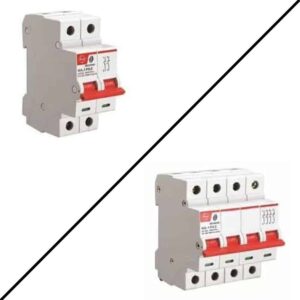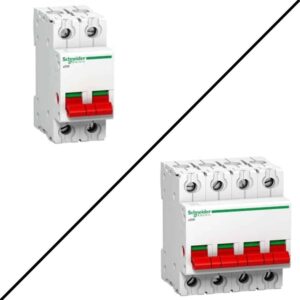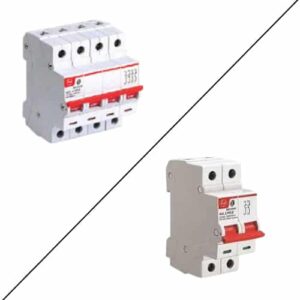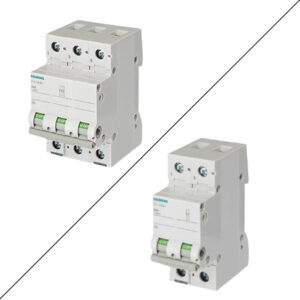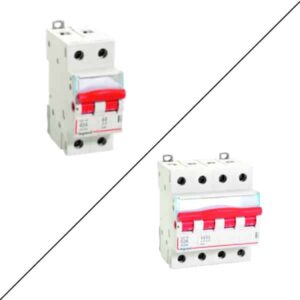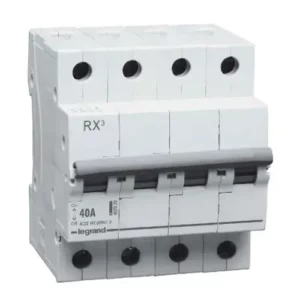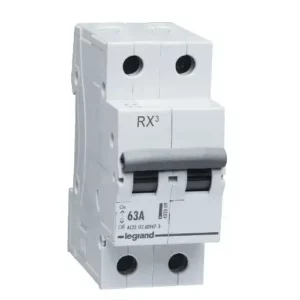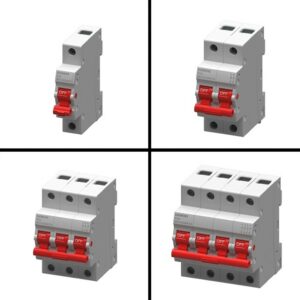Isolators | Isolator Switch
Difference Between MCB’s and Isolators
Isolators are very similar to Miniature Circuit Breakers and can be easily confused. The basic difference between the two devices is this:
MCBs an automated switch that provides protection from overloads and short circuits.
Isolators are manually operated switches that are used to de-energize a part of a circuit for service or maintenance.
This is the basic premise of their purpose. MCBs are on-load devices whereas Isolator is off-loaded devices, with very low breaking capacity, intended to be opened only after the current has been interrupted by some other control device. Isolators are usually used in power substations and high voltage devices such as transformers, etc. Isolators restrain DC signals and make way for AC signals to pass. They are advised not to be opened in on-load conditions. They are usually used in circuit breakers (at both ends) so that the circuit breaker can be inspected upon for maintenance.
Diagram Showing the Placement of Isolatorson a Circuit Breaker(CB)
Types of Isolators:
Based on Their Application:
Double Break Type–This type of isolator consists of three loads of post insulators. The middle insulator holds a tubular contact that can be turned straightly by a spin. The rotation of the middle insulator can be done by a lever mechanism at the bottom of that insulator; also it is related to manual operation (operating handle) of the isolator via a mechanical knot rod.
Single Break Type-In this type of isolator switch, the arm contact is separated into two elements. The first arm contact holds male contact; the second arm contact holds female contact. The arm contact shifts because of the rotation of the insulator on which the arm contacts are fixed.
The post insulators rotations stay in reverse to each other which allows it to shut the isolator switch by shutting the arm contact. Insulators’ counter-rotation stays to open the arm contact, as well as an isolator switch, rotate into an off condition. Generally, the motor-operated isolator is used as an emergency, a manually operated isolator is also offered.
Pantograph Type– The pantograph type isolator permits the current switchgear installation, and it requires the least space. These insulators include both post insulators and operating insulators.
MCB Isolator– These are used to provide protection in domestic scale wiring and low-power commercial establishments. Hence these are ideal for use at homes, small offices, or residential complexes. Just like an MCB, MCB isolators also come in single pole, double pole, triple pole, and four-pole configurations.
According to The Location in The Power System, There are Three Types:
Bus Side
It connects by the major bus
Line Side
Stays connected by a feeder in the line
Transfer Bus Side
Connects to the transfer bus
Depending on Line Voltage,
Low Voltage
These are designed to endure up to 11KV.
Medium Voltage
These can withstand between 11KV to 66KV.
High Voltage
These are used in circuits where 66KV to 330KV is used.
Operation of Isolator:-
The operation of an electrical isolator can be done by the following two operations, namely opening and closing.
Opening Operation of Electrical Isolator
Open the major circuit breaker.
Open the Isolators on both ends of the circuit breaker.
Close the earth switch.
Closing Operation of Electrical Isolator
Open the earth switch
Shut the Isolators
Close the circuit breaker
Comparison Between Isolators and Circuit Breakers:
Isolators
Circuit Breakers
It’s meant only for interrupting the power during maintenance or repair.
Circuit breakers are meant for protecting a circuit or equipment from short circuits and overload while they are in operation.
Can be operated only during offload.
They can be operated under on-load and offload situations.
The breaking capacity of isolators is very less.
The breaking capacity of circuit breakers is high.
Isolators can shut off a part of the circuit in case of a fault. The remainder of the circuit receives current without interruption.
Circuit Breakers like ACB and MCB, if tripped turn off the flow of current in the whole circuit.
An isolator does not require the presence of Relay to be operational.
Circuit breakers cannot function without Relay.
Has to be operated manually.
Can be operated manually or automatically.
Application of Isolators:
The applications of the isolator are as follows in high voltage devices like transformers and high voltage circuit breakers.
These are protected with a security mechanism to prevent careless use.
When a fault occurs in a substation, then the isolator cuts out a portion of a substation.
They are used to de-energize the circuit/ part of a circuit, for maintenance and safety.
Isolators in Microwaves:
Isolators are used in microwave ovens as well. You did not know, did you? Well, it is true. Microwave ovens use different kinds of electrical isolators; these isolators are two-port devices that allow the transmission of microwave power in a singular direction. It employs vertical and horizontal polarization and uses it to prevent the energy signals from being sent from the input side to the output side to be reflected backward.
These isolators are generally made up of magnetic substances or ferrite materials. While choosing a microwave isolator, make sure that it is of such quality that it makes the least amount of noise when used in the system; this is called insertion loss.
Significance of Isolators:-
So far we have been discussing isolators and their different types and functions. Now we must focus on why they are absolutely necessary for the safety of both electrical equipment and the people operating this equipment. Firstly, isolators are safety devices. It ensures that the circuit has been de-energized so that it can be safely inspected and maintained. Many people may argue that an isolator and an MCB serve the same purpose. Apparently, that statement may sound true but the purpose served by MCBs and isolators is very different. MCBs under normal conditions can be used to cut the power sources to the entire circuit. However under circumstances, such as a short circuit or power overload, the MCB may trip to sever the flow of current into the circuit and save the appliances but it might still be dangerous to touch the MCB because it may carry a huge amount of static charge. This is where isolators save the day. When the isolator is closed it grounds any remaining charge in the circuit and makes it safe to operate and check for further damages.
Major Manufacturers:
Major Manufacturers of MCB Isolators are Siemens, Schneider Electric, Legrand, and L&T.
 (+91) 7439 448 917
(+91) 7439 448 917 Cash on Delivery Available
Cash on Delivery Available



 Circuit Breakers
Circuit Breakers Power Distribution
Power Distribution Modular Switchboard
Modular Switchboard Wires & Cables
Wires & Cables
















